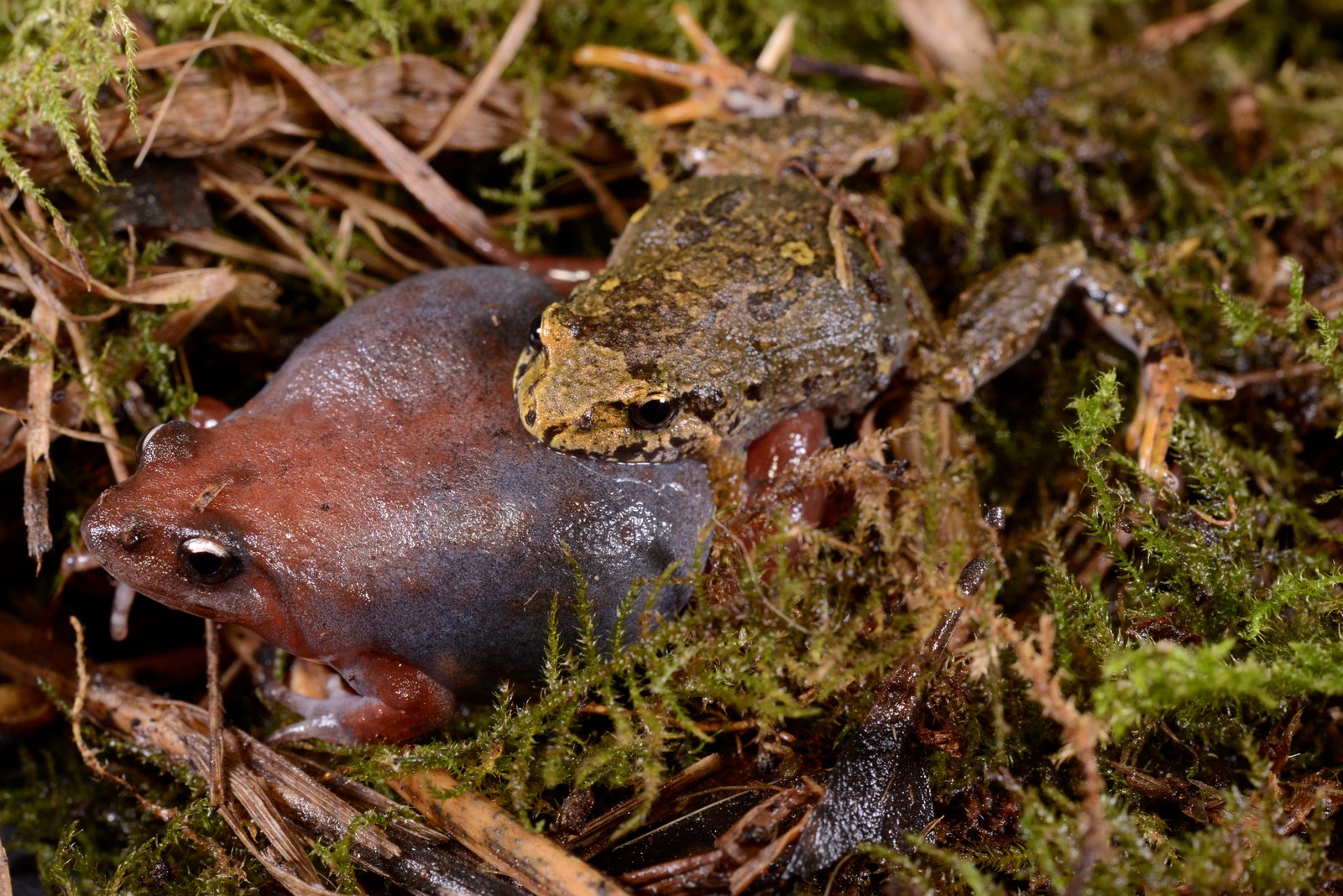Smooth operators: Introducing a tiny new smooth frog from southern Victoria
Hidden in plain sight in the forests of Victoria’s Otway Plains and Ranges, we describe a new smooth frog to science, with an unusual reproductive mode.
The Australian smooth frogs (Geocrinia) are found in moist, temperate habitats of south-eastern Australia, with a single species, the Ticking Frog (Geocrinia leai), found in south-western Western Australia. Smooth frogs are generally small (up to 3.5 cm) and have an interesting mode of reproduction, where their eggs develop on land. Males will staunchly guard the terrestrial nest and it’s not unusual for them to attract multiple females to lay their eggs in the nest pile (they certainly are smooth operators!). After several months, predictable winter or spring rainfall eventually floods the nest and the tadpoles hatch and complete their development aquatically.

Male Eastern Smooth Frog (Geocrinia victoriana) guarding a terrestrial nest of eggs. Often multiple females will lay their eggs in the nest, and the male will guard them until rainfall eventually floods the nest and the tadpoles hatch and complete their development in water.
Image: Thomas Parkin© Australian Museum
Two species were thought to occur in south-eastern Australia: the Southern Smooth Frog (Geocrinia laevis) and the Eastern Smooth Frog (Geocrinia victoriana). The Southern Smooth Frog is distributed in Tasmania, western Victoria and the extreme south-east of South Australia, while the Eastern Smooth Frog is distributed across south-eastern Victoria and just into NSW. The two species can be very difficult to tell apart based on appearance, but they have strikingly different sounding calls – one sounds like a creaking door and the other like a pedestrian crossing! Where the species overlap, a small hybrid zone exists, and the hybrids have a strange call that sounds half-way between the two species.

Map showing distribution of the smooth frog (Geocrinia) complex in south-eastern Australia. Hybrid zones are formed where the species distributions overlap.
Image: Thomas Parkin and Jodi Rowley© Australian Museum
By listening to over 800 recordings of smooth frog calls submitted by citizen scientists to the Australian Museum’s FrogID program, we began to hear subtle differences across each species’ ranges. We also noticed the populations seemed to be fragmented across major biogeographic barriers, which can often indicate long-term isolation.
In our recent study, we took a deeper look at the south-eastern smooth frogs using a combination of genetics, comparisons of body shape, and analyses of acoustic recordings submitted to the FrogID program. Our investigation revealed that instead of two species in the south-eastern group, there were three! The third species, which we name the Otway Smooth Frog (Geocrinia sparsiflora), is found only within Victoria’s Otway Plains and Ranges. The species is very similar in overall appearance and call to the Eastern Smooth Frog, however, it is genetically divergent and can be distinguished by the bright, flower-like spots which are often present on its back and sides. We believe that the Otway Ranges have provided a refuge for the Otway Smooth Frog through thousands of years of climate instability in southern Australia.

Otway Smooth Frog (Geocrinia sparsiflora), a new species described in our study. The species name sparsiflora is derived from the Latin words sparsus meaning ‘sparse or scattered’ and flora for the Roman goddess of flowers. This is in reference to the sparse, flower-like spots characteristic of this species.
Image: Thomas Parkin© Australian Museum
The Otway Smooth Frog has the most restricted distribution of all the species, which is of concern when it comes to their long-term survival. However, at present, the new species appears to occur in relatively high abundances and have some tolerance for disturbance, being found breeding in modified habitats in agricultural and suburban areas.

Otway Smooth Frogs (Geocrinia sparsiflora) mating. The males will clasp onto the larger females until fertilisation of the eggs is complete. This position is known as ‘amplexus’.
Image: Thomas Parkin© Australian Museum
While the Otway Smooth Frog does not currently appear threatened with extinction, future climate change projections in southern Victoria are concerning. Projections for increases in temperature, changes in fire regimes, and overall decreases in autumn and winter rainfall (when the species breeds) may have significant consequences for its ongoing survival. Thankfully, now that the Otway Smooth Frog has been formally identified and scientifically named, it will be included in future biodiversity and conservation assessments.
Tom Parkin, Research Assistant, Australian Museum.
Jodi Rowley, Curator, Amphibian & Reptile Conservation Biology, Australian Museum.
Acknowledgements
We thank the Australian Biological Resources Study National Taxonomy Research Grant program for providing the funding required to conduct this research (Activity ID: 4-EHPVRVI). We also thank the dedicated citizen scientists of Australia whose submissions to FrogID are helping us better understand and conserve Australia’s frogs.
More information
- Parkin, T., Donnellan, S.C, Parkin, B., Shea, G.M., Rowley, J.J.L. (2023). Phylogeography, hybrid zones and contemporary species boundaries in the south-eastern Australian smooth frogs (Anura: Myobatrachidae: Geocrinia). Molecular Phylogenetics & Evolution. 189, 2023, 107934. https://doi.org/10.1016/j.ympev.2023.107934

